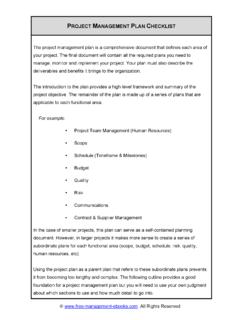Transcription of Principles of Team Building - Free Management …
1 Principles of team BuildingLeadership SkillsTeam 978-1-62620-987-9 Copyright Notice 2013. All Rights ReservedISBN 978-1-62620-987-9 The material contained within this electronic publication is protected under International and Federal Copyright Laws and treaties, and as such any unauthorized reprint or use of this material is strictly may not copy, forward, or transfer this publication or any part of it, whether in elec-tronic or printed form, to another person, or or translation of any part of this work without the permission of the copy-right holder is against the downloading and use of this eBook requires, and is an indication of, your complete acceptance of these Terms of Use. You do not have any right to resell or give away part,or the whole.
2 Of this 978-1-62620-987-9 1 Principles of team BuiLdingTable of contentsPreface 2 Visit Our Website 3 Introduction 4 Principles of team Building 6 Define Success Criteria 8 Lead by Example 8 Value All Contributions 9 Reward Group Success 10 Beware of Teams in Name Only 12 team Examples 13 Development team Example 14 Challenges you are most likely to encounter 16 Customer Support team Example 21 Challenges you are most likely to encounter 23 Steering team Example 27 Challenges you are most likely to encounter 29 Summary 34 Other Free Resources 35 References 36 ISBN 978-1-62620-987-9 2 Principles of team BuiLdingPrefaceSuccessful team Building in the workplace has more to do with making a success of the team you have been given, rather than Building an ideal team from scratch.
3 There are certain core Principles of team Building that will help you get the best out of any team that you find yourself managing. You will learn how to apply these Principles to: A project team where even though you are not an expert in all of the technical aspects of the project you are still expected to coordinate the team s efforts. A support team where there are problems with motivation and high staff turn-over. A high-level strategic team where you do not have any direct authority over the other 978-1-62620-987-9 3 Principles of team BuiLdingVisit our WebsiteMore free Management eBooks along with a series of essential templates and check-lists for managers are all available to download free of charge to your computer, iPad, or Amazon are adding new titles every month, so don t forget to check our website regularly for the latest ISBN 978-1-62620-987-9 4 Principles of team BuiLdingintroduction You will probably have been a member of several teams during your life for example, a sports team , theater group, church group, bridge club, etc.
4 As a result, you should al-ready have some understanding of how teams function and what motivates them to be successful. As useful as this knowledge is, it is worth pointing out some of the differences between these types of non-work teams and those teams that you will need to manage as part of your job. Firstly, teams that are outside of a working environment are usually made up of people who have a common set of beliefs and have actively chosen to join. Secondly, the team objective will be clear and universally agreed. Thirdly, anyone who does not fit in with the group will tend to leave of their own accord. Finally, in the case of a sports team , the captain can field the best players and leave the rest on the bench.
5 Things are very different with workplace teams. As a manager you will often be presented with a team to manage which may or may not have a track record of success. Some of the team members may be enthusiastic, but some may not. People who don t fit in or who don t agree with the goals of the team may be reluctant to leave and it may be impossible to get rid of them. In addition, the people in your team are unlikely to have a common motivator as each one is influenced by their own personal career aspirations. Sometimes, the goals that the team has been set may be either impossible to achieve or inappropriate. Despite all of these constraints, there are certain core Principles of team Building that will help you get the best out of any team that you find yourself managing.
6 This eBook explores three very different teams and describes how the Principles of team Building can be applied to each one. These example teams have been chosen because they represent the three most common types of team in the modern first example is typical of a multi-disciplinary project team that has been assembled to complete a particular piece of work. In this example, the team leader does not have total managerial control over all of the team members, which is normal with this type of team . ISBN 978-1-62620-987-9 5 Principles of team BuiLdingThe second example is typical of a team that is performing an ongoing business process, in this case telephone support. In this example, the issues facing the team leader have more to do with maintaining team morale than with the work itself, which is reasonably straightforward.
7 The third example is typical of a team that is engaged in strategic planning. In this ex-ample, none of the team members report directly to the team leader and the goals of the team are changing all the time. The issues facing the leader of each of these teams are discussed in detail. Even if your team does not match one of these scenarios exactly, there are still certain Principles that will apply to your own team and it is up to you to interpret how best to apply them. A Note About team LeadershipThe most important part of leading a team in the modern workplace is to be the person that others choose to follow. Even where compulsion is possible, it tends not to work very well. If you want to take a leadership role, then the most important questions you can ask are:Which leadership style is the most appropriate to my team ?
8 How can I alter my behaviors to become this type of leader?The answers to these questions depend on your role, your team , and the task at hand. This aspect of team leadership is covered in the eBook team Leadership Styles, which you can download free from ISBN 978-1-62620-987-9 6 Principles of team BuiLdingPrinciples of team BuildingThere has been a lot of academic study of teams and team Building over the years and much of it has found its way into team Building books aimed at managers. As a result, there are certain aspects of team Building that have gained the status of Golden Rules that you should follow in order to build and manage a successful good example of this is team size. Academic studies have shown that the ideal team size is between five and nine, with six being the ideal Size 5-9 people ideal is 6 The effect of team size on productivity can be traced back to the work of Maximilian Rin-gelmann, a French agricultural engineer born in 1861.
9 He discovered that the more people who pulled on a rope, the less effort each individual contributed, despite the total force generated by the group rising. This effect became obvious after there were about five people on the rope. Ringelmann attributed this to what he called social loafing. This happens because working as part of a group or team tends to obscure the lack of individual effort. The impact of social loafing is more significant where each team member is performing exactly the same mundane task. With this type of task it is very difficult for anyone to tell how much effort any one individual is putting in and very difficult to reward an individual, or give that person a sense of achievement.
10 Not surprisingly, this results in individuals putting in as little effort as they think they can get away well as Ringelmann s work, there have been innumerable studies involving team - Building programs and a large number of companies that have designed games specifi-cally to test the factors affecting team cohesion, trust, and cooperation as well as the quality of the work done by various teams. The ideal team size to achieve the objectives set by these exercises seems to be around five or six. ISBN 978-1-62620-987-9 7 Principles of team BuiLdingThis evidence does appear to be slightly more compelling than the Ringelmann experi-ment, but you should remember that the tasks set in this type of exercise are often de-signed with a fairly small group in mind.














